Kicking off our golden anniversary year with 50 must-dos in 2025

Holy City steeples including St. Michael’s in the foreground and St. Philip’s behind it; (inset) French Huguenot Church.
St. Philip’s Church formed in 1681 at the corner of Meeting and Broad streets, making it the first religious congregation in the colony of South Carolina. After a hurricane damaged the structure in 1710, St. Philip’s moved to its current location at 142 Church Street, leaving the old plot to become St. Michael’s. Both lie at the center of the Holy City’s Christian roots, and their interiors appear much as they would have centuries ago. If you’ve got several Sundays to spare, visit Circular Congregational Church (150 Meeting Street, founded in 1681), the French Huguenot Church (136 Church Street, founded in 1687), First Scots Presbyterian (53 Meeting Street, 1731), and the Unitarian Church (4 Archdale Street, founded in 1772), each of which still hold services in their own unique style of worship. Charleston also has the country’s first Reform Judaism synagogue, Kahal Kadosh Beth Elohim (90 Hasell Street, congregation founded in 1749). On Calhoun Street, visit Mother Emanuel AME, the oldest African Methodist Episcopal congregation in the South. Pay respects to the lives lost in the 2015 massacre there and be awed by the resilient, forgiving nature of this parish. Sunday services are open to the public and streamed live via Zoom.
Web Extra: Listen to Charleston’s church bells
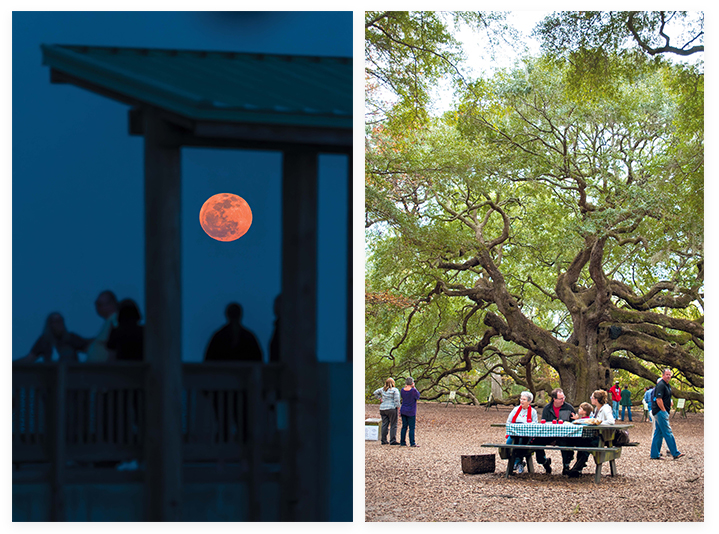
(Left) A full moon over Folly Beach as seen from the pier; (right) The Angel Oak.
Charleston’s southeasterly perspective makes for incredible views of rising full moons. Just before dusk, scout out your spot at White Point Gardens, Breach Inlet, or the north end of Folly Beach and wait for the lunar light show.
Full moons in 2025 fall on:
January 13
February 12
March 14 (Blood Moon, a full lunar eclipse)
April 12
May 12
June 11
July 10
August 9
September 7
October 6 (Supermoon)
November 5 (Supermoon)
December 4 (Supermoon)
While you’re stargazing, look out for the Quadrantids meteor shower the night of January 2.
We’ve got nothing on the polar bear plungers in Alaska who dive into the icy ocean on New Year’s Day, but it’s still pretty chilly in the Atlantic on January 1 (and a great way to shake off any jitters from the previous night’s festivities). Thousands of people brave the waters each year in a tradition started by Dunleavy’s Pub on Sullivan’s Island 30 years ago. Donations benefit Special Olympics South Carolina, so you’re “Freezin’ for a Reason.” Across the harbor, Folly Beach hosts its 11th annual Bill Murray-themed plunge this year (visitfolly.com/bill-murray-polar-plunge). The Folly plunge is at 1 p.m. and Sullivan’s at 2 p.m., so it’s feasible for the hardiest plungers to double dip.
The South’s most iconic individual tree now grows on 44 protected acres that will soon become the Angel Oak Preserve, featuring boardwalks, a nature play area, and parking farther from the tree’s root system than currently possible at the existing nine-acre city park. You don’t have to wait for the new preserve to open to pack a sandwich and sit in the shade for an afternoon of arboreal royalty. But you can help speed the project along with a donation to the Lowcountry Land Trust. Angel Oak Park: Monday-Saturday, 9 a.m.-5 p.m.; Sunday, 1-5 p.m. 3688 Angel Oak Rd., John’s Island, charleston-sc.gov/153/Angel-Oak; lowcountrylandtrust.org
Southerners everywhere eat hoppin’ John for good luck, but the superstition’s roots lie in the Lowcountry. Historians don’t quite agree about why it’s eaten on the first of January, but the one-pot dish of peas, pork, and rice originates from enslaved African Americans on rice plantations.
Improvisation is encouraged—cook black-eyed peas in a pot with a ham hock, and then stir in rice with onions and spices, along with a heaping side of collard greens. For those in need of further instruction, we recommend this preparation:
(SERVES 4-6)
1/2 lb. dry black-eyed peas, cow peas, or field peas
2 small smoked ham hocks
6 cups water
1 small onion, finely chopped
1 Tbs. dried thyme
1 1/2 cups rice
Rinse peas with cold water and pick out any stones or bad peas. Soak in warm water for 35 minutes. Drain and set aside.
Combine ham hocks and water. Boil for two hours and 45 minutes. Add peas, onion, black pepper, and thyme. Cook for 45 minutes to an hour, or until tender. Add rice, stir, and simmer over medium heat for 20 to 25 minutes or until rice is tender.
Web Extra: For more fun facts about hoppin’ John, visit charlestonmag.com/features/hoppin_john
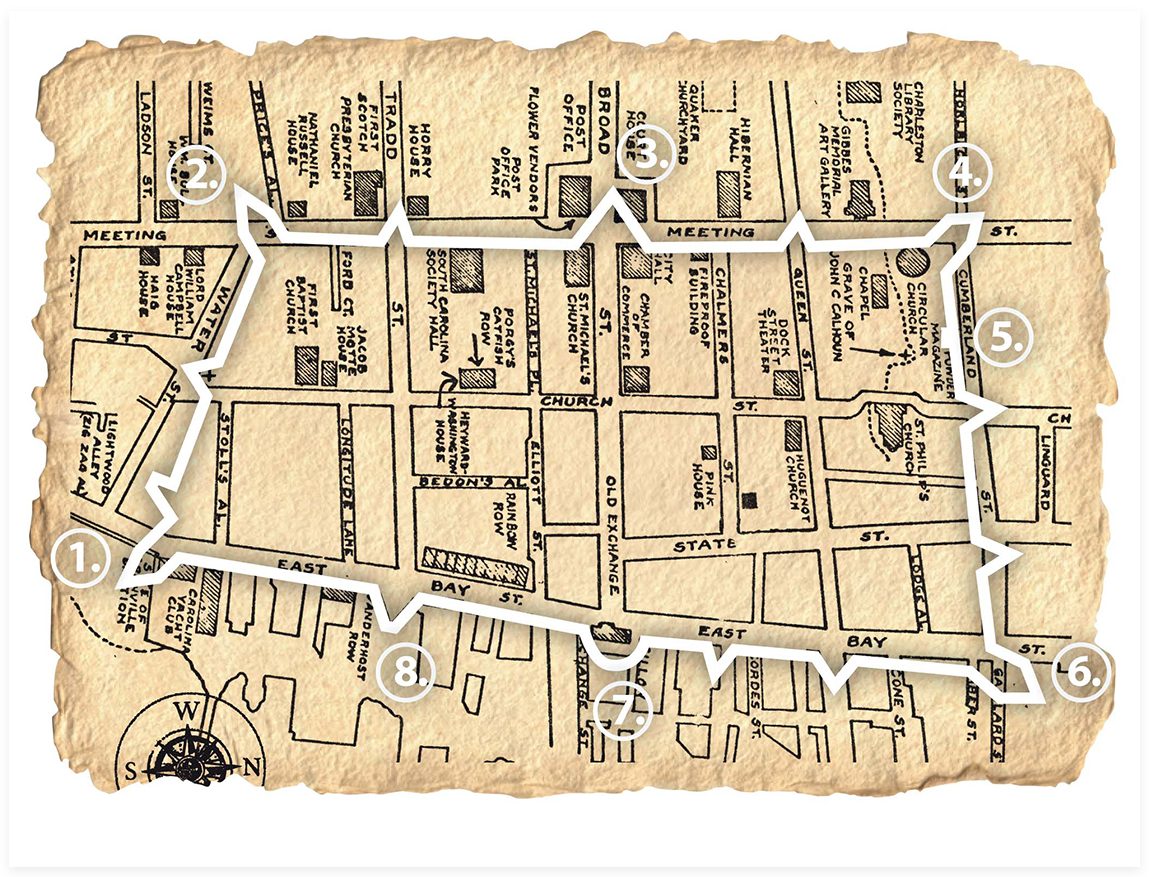
In Charleston’s early days, between the 1690s and 1730s, the Spanish, French, and Native Americans posed a threat to the existence of the fledgling colony. The early settlers built a fort-like wall around the city—running roughly along the rectangle formed between Meeting and East Bay streets and sided by Cumberland and Water streets—for added protection. Bronze markers now note where walls once stood. Walk the perimeter and try to find all eight bastion markers, then duck into the cellar of the Old Exchange and Provost Dungeon for a peek at a portion of the wall visible to the public.
Web Extra: Read more about the bastion markers
Throw a Cast Net
Throwing a cast net is an essential Lowcountry skill, and hauling one in that’s teeming with juicy shrimp sets off joy receptors. You’ll need a boat, a cast net, and a fishing license. If you really want to dial it in, shrimp-baiting season runs from mid-September to mid-November. Add bait balls (a pungent mixture of clay and fish meal), PVC poles to mark your bait location, and a shrimp-baiting permit, and you can “cooler out” with up to 48 quarts of crustacean gold. Hot spots include the North Edisto River near Cherry Point boat landing, the banks of Charleston Harbor, and behind Bulls Island. Shrimp taste sweetest when you haul them in yourself.
Web Extra: Learn how to throw a cast net

Folly Beach
There’s nothing like the feel of moving through time and space—and water—atop a surfboard. Charleston’s surf breaks on Folly Beach and the Isle of Palms aren’t known for their size or shape, but the sandy-bottom beach breaks are beginner friendly (unless there’s a storm offshore whipping up a big swell). On Folly, you can paddle out anywhere except 2nd Street East to 3rd Street West (during summer, when this is a designated swimming area). Beginners should skip the Washout, where the waves typically break most consistently, attracting the largest crowds. The beach break on Isle of Palms is fairly consistent across the island.
If you need a board, rent one on Folly at McKevlin’s Surf Shop ($40/day for a hand-shaped board) or Ocean Surf Shop ($30/day). Better yet, improve your skills with a lesson from Carolina Salt; owner Kyle Busey is a Folly Beach surf legend. On the Isle of Palms, marine biologist and big wave surfer Philip Antman teaches individual and group lessons at Salt Marsh Surf Company.
Carolina Salt: carolinasaltsurflessons.com
McKevlin’s Surf Shop: 8 Center St., Folly Beach, mckevlins.com
Ocean Surf Shop: 31 Center St., Folly Beach, oceansurfshop.com
Salt Marsh Surf Company: Isle of Palms, saltmarshsurf.com
In the 18th and 19th centuries, Madeira (wine from the tiny Portuguese island of the same name) was the local drink of choice. Madeirans discovered that the wine leftover on ships after steamy transatlantic voyages to the tropics had a distinct appeal all its own. For a taste of our forefathers’ favorite quaff, pick up a bottle of Charleston Sercial Special Reserve. Amber in color with a dry finish, it’s wonderful served with she-crab soup or local fish. For a sip with a view, visit the Edmondston-Alston House on January 15 for a candlelight tour and a sampling of Madeira on the second-story piazza overlooking Charleston Harbor (middletonplace.org).
Trash in the ocean harms wildlife, from strangling birds to choking sea turtles to microplastics that build up in the fish that we eat. Some of the trash on our beaches originates at home—please don’t litter!—but a lot of it washes up from somewhere else across the ocean. We can do our part every time we visit the beach by picking up any trash we see in the sand rather than walking by it. In addition, sign up to join one of the monthly and annual beach sweeps that occur across the area.
SC Sea Grant Consortium Beach Sweep: Join the effort on the third Saturday in September across the Lowcountry’s beaches. scseagrant.org
Isle of Palms Clean Up Crew: Make friends while lending a hand for an hour every Monday evening and Wednesday morning. iop.net
Toby’s Spooktacular Sweep: Wear your costume for this annual sweep on the Sunday before Halloween on Folly Beach. visitfolly.com

In late spring, often concurrent with Spoleto Festival USA, at least three downtown churches open their doors for daily “tearoom” lunches, featuring Lowcountry classics such as okra soup, shrimp salad, and Huguenot torte. Grace Episcopal even hires a pianist for the occasion, but you can’t go wrong with the food at St. Philip’s or at Second Presbyterian, either. Even more than the grub, the gatherings are a who’s who of local characters, those dining as well as the volunteers serving the meals.
For a year-round tearoom experience, take a day trip up Highway 17 to Georgetown’s circa-1740 Hopsewee Plantation for a full Lowcountry lunch in the River Oak Cottage.
Grace Episcopal: 98 Wentworth St., gracechurchcharleston.org
St. Philip’s Episcopal: 142 Church St., stphilipschurchsc.org
Second Presbyterian: 342 Meeting St., 2ndpc.org
Hopsewee Plantation: Tearoom is open Tuesday-Saturday, 11 a.m.-3 p.m. Reservations are recommended. 494 Hopsewee Rd., Georgetown, hopsewee.com
Redfish (also called red drum or spottail) are the prize catch of local inshore fishing, and the biggest ones hang out along the rocks at the Charleston Jetties. “Reeling in redfish over three feet at the jetties is common,” says Captain Geoff Bennett of Charleston Charter Fishing (charlestoncharterfishing.com). Whether you charter a trip or take your own boat, follow Bennett’s tips for jetty fishing:
■ Anchor on the outside of the jetties—not inside, where you could get crushed by cargo ship wake!
■ Use a heavy rod with a “Fish Finder” rig that includes two to four ounces of weights, an 80-pound test leader, and a size 7/0 circle hook.
■ The most effective baits are menhaden, mullet, and blue crab.
On the further ends of Charleston, Captain Mike Illig of Avid Angling (avidangling.com) is an expert (including fly-fishing and tarpon trips) in Bulls Bay, while Captain Brian Hawkins (hawkinsfishingcharters.com) knows where to find the big ones around the Folly River ecosystem.
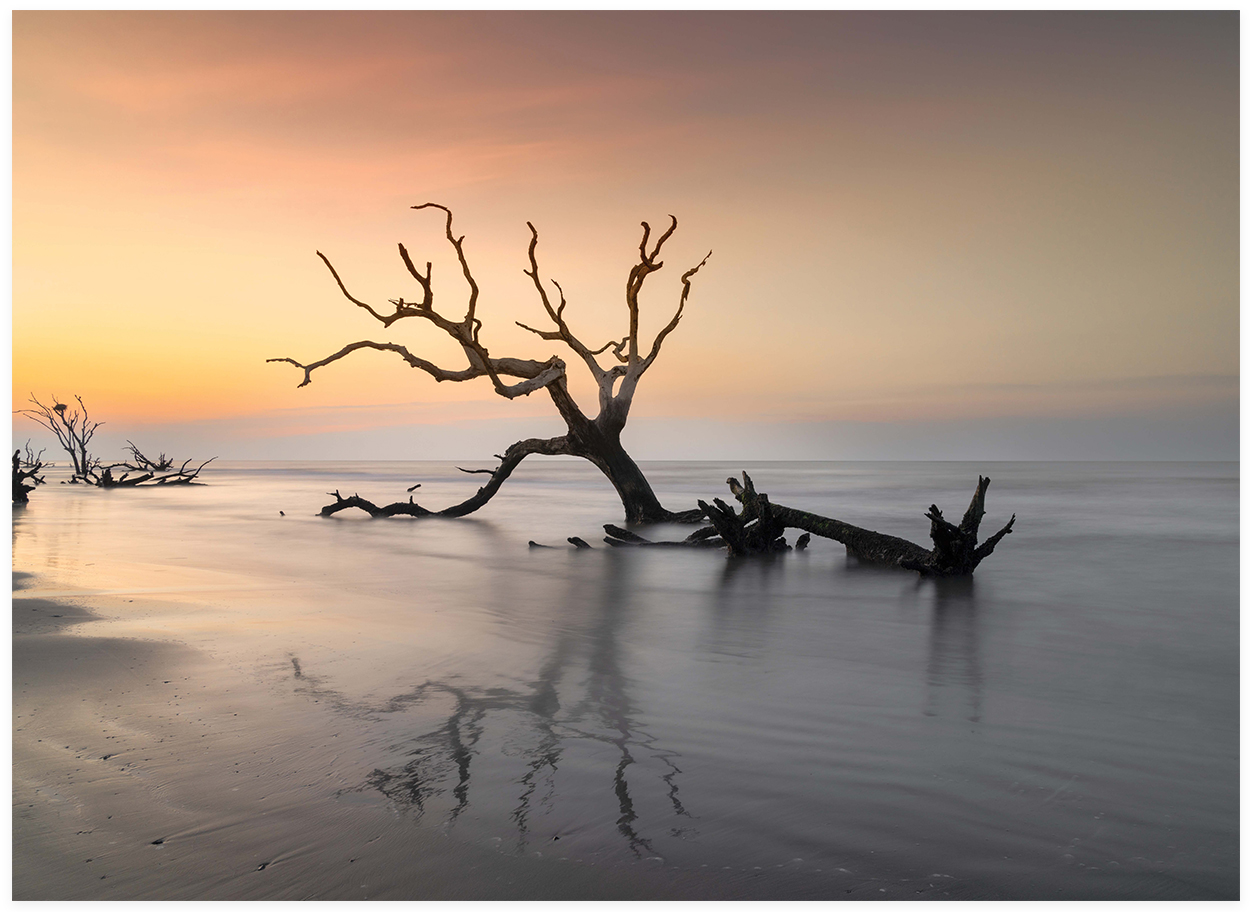
The boneyard beach on Bulls Island.
The Lowcountry’s most stunning beaches occur where the ocean overtakes the maritime forest, leaving the skeletal remains of tree trunks hanging on in the surf. These “boneyard beaches” occur on islands where erosion is allowed to take its natural course. The easiest place to witness this phenomenon is on the far northeastern edge of Folly Beach at Lighthouse Inlet Heritage Preserve. To truly get lost in an ancient sandy forest, however, head to Edisto Beach’s Botany Bay Plantation. There’s no shell collecting allowed at Botany, so walk to the north and you’ll encounter more giant whelk shells dotting the shoreline than you can count. Closer to town, hitch a ride on Coastal Expeditions’ Bulls Island Ferry to the vast boneyard in the Cape Romain National Wildlife Refuge. Or if you have your own boat (or kayaks and strong arms), secure a free permit from the DNR to camp on Capers Island for the night, where you can wander through a truly desolate boneyard beach while the moon rises over the ocean. Just don’t forget the bug spray!
Lighthouse Inlet Heritage Preserve: 1750 E Ashley Ave., Folly Beach; ccprc.com
Botany Bay Plantation Heritage Preserve (Botany Bay Rd., Edisto Island) and Capers Island Heritage Preserve are managed by the South Carolina Department of Natural Resources. dnr.sc.gov/mlands
Bulls Island Ferry: Garris Landing, 498 Bulls Island Rd., Awendaw; coastalexpeditions.com
Web Extra: Read our feature on how Bulls Island rebounded from Hurricane Hugo
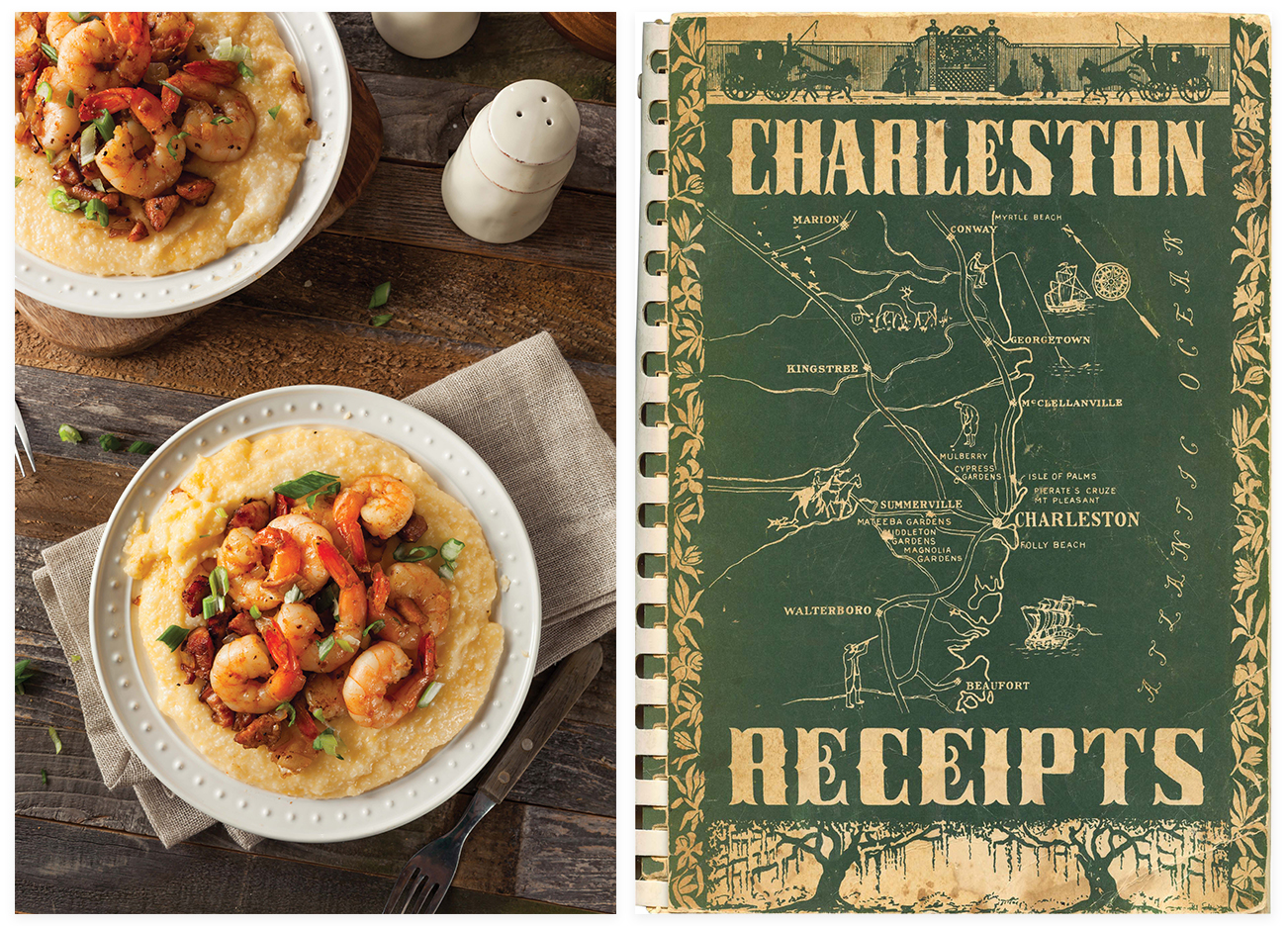
There’s no one right way to make shrimp and grits, but we’ve certainly tried a few cooked the wrong way. If you’re a novice, start your journey in the pages of Charleston Receipts, first published by the Junior League in 1950—a time when “whole foods” meant that you used the whole stick of butter. You can find a copy in most Lowcountry natives’ kitchens or order the 2021 update (we found editions dating back to the 1950s on eBay).
“Shrimp…have long been a breakfast favorite in the coastal region, and they are always served with hominy,” reads the introduction to “Shrimp for Breakfast.” Start with the league’s Breakfast Shrimp receipt by Mrs. Ben Scott Whaley (Emily Fishburne). Once you’ve perfected it, you wouldn’t be faulted for substituting butter, serving them over cheese grits, or creating your own “receipt.”
Breakfast Shrimp
(Serves 4)
1½ cups raw, peeled shrimp
2 Tbs. chopped onions
2 tsp. chopped green pepper
3 Tbs. bacon grease
1 tsp. Worcestershire sauce
1 Tbs. catsup
1½ Tbs. flour
1 cup water or more
Fry onion and green pepper in bacon grease. When onion is golden, add shrimp; turn these several times with onion and pepper. Add enough water to make a sauce—about one cup. Do not cover shrimp with water or your sauce will be tasteless. Simmer two or three minutes and thicken with flour and a little water made into a paste. Add seasoning, Worcestershire sauce, and catsup. Cook slowly until sauce thickens. Serve with hominy.
*Excerpted with permission from the Junior League of Charleston (jlcharleston.com)
Erosion can be bad news for our beaches, but it brings promise for treasure seekers. After a storm or period of big waves, head out to any local beach on a morning low tide to sift through the eroded banks for shark teeth—you might even get lucky and find a palm-sized prize from a megalodon. The most avid hunters have their secret spots, and they’re not sharing, but here’s a hint: you’ll need a boat or kayak to reach them. Make Google Earth your friend and find a flat beach with steep banks that can only be accessed by water.
If you want to guarantee a good hunting location, book a trip with Charleston Fossil Adventures, owned and staffed by paleontologists who can share fascinating details about your finds (and show off a few special pieces from their own collection).
Charleston Fossil Adventures: (843) 534-9099, chsfossiladventures.com
Nearly 50 species live at the Center for Birds of Prey in Awendaw, where you can witness the majesty of owls, eagles, and falcons as they soar during flight demonstrations every Thursday, Friday, and Saturday. The center is primarily a research and rehabilitation institution, but its public programs let visitors see these incredible animals up close. Each February, the birds take a star turn at the Southeastern Wildlife Exposition, when daily flight demonstrations are one of the festival’s top draws.
Avian Conservation Center/Center for Birds of Prey: 4719 Hwy. 17 N, Awendaw; thecenterforbirdsofprey.org
Southeastern Wildlife Exposition: February 14-16, sewe.com
If you’ve never tested your mettle in the Cooper River Bridge Run (bridgerun.com), this is the year to try. Start training now as the 40,000-person, 10K goes down on April 5. Then stay in shape for Thanksgiving’s Turkey Day Run and Gobble Wobble 5K (a tradition since 1914; turkeydayrun.com) and the Reindeer Run, held the second Saturday in December (reindeerrun.org). Both draw thousands of participants and benefit local charities—not a bad way to justify all those extra holiday treats.
If running over bridges is your thing, you’ve got two more options: the Isle of Palms Connector Run (ioprun.com) and the James Island Connector Run (facebook.com/JamesIslandConnectorRun) happen every October.
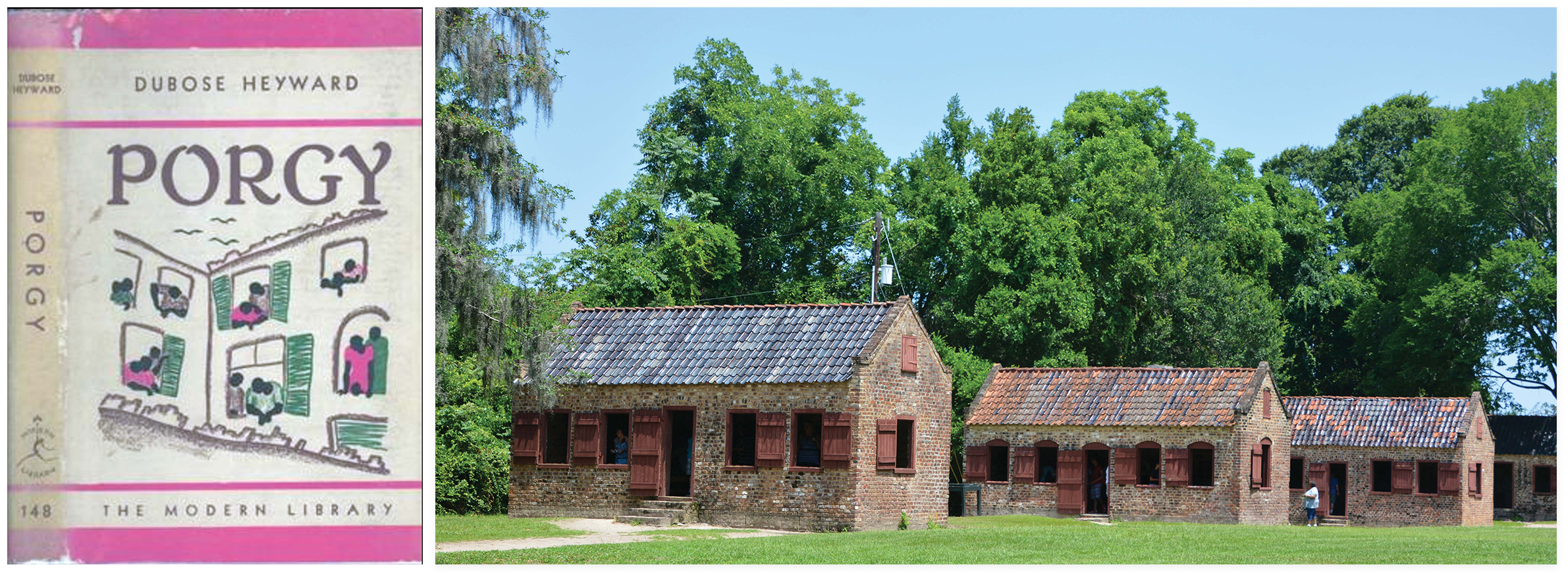
(Left) The author DuBose Heyward's novel, Porgy. (Right) Boone Hall Plantation’s “Black History in America” tour includes nine preserved cabins, built between 1790 and 1810.
It’s no wonder that the slow, distinctive roll of the song “Summertime” had its roots right here in the steamy Lowcountry. In 1934, composer George Gershwin spent the summer on Folly Beach collaborating with author DuBose Heyward, a Charleston native who had penned the novel Porgy nine years prior. The resulting musical, Porgy and Bess, debuted on Broadway in 1935. Buy a copy of Porgy, then take a walk past “Cabbage Row,” the 18th-century tenement at 89 and 91 Church Street, where cabbages and vegetables were sold by the African American residents around the turn of the 20th century. Heyward took the artistic liberty of renaming the spot “Catfish Row” for his book, a name Gershwin further popularized through the music for his subsequent play.
Charleston’s early prosperity was built upon the suffering of millions of enslaved people who passed through our port. Take time to quietly reflect on their sacrifices and the ramifications in our society today in the intact cabins and graveyards maintained at the Lowcountry’s former plantations. Charleston historian Joseph McGill Jr. brought these stories back to the forefront through the Slave Dwelling Project (slavedwellingproject.org), now a nonprofit that helps protect these structures and their histories across the South.
Middleton Place offers its “Beyond the Fields” program four times daily, and McLeod Plantation, managed by Charleston County Parks & Recreation, builds the whole visitor experience around the juxtaposition of its enslaved cabins and the family home. Boone Hall’s self-guided “Black History in America” program includes exhibits in each historic dwelling. At Magnolia Plantation & Gardens, four preserved dwellings form the core of their “From Slavery to Freedom” tour.
Boone Hall Plantation & Gardens: Open Monday-Saturday, 9 a.m.-5 p.m., & Sunday, noon-5 p.m. 1235 Long Point Rd., Mount Pleasant, boonehallplantation.com
Drayton Hall: Wednesday-Monday, 9 a.m.-5 p.m. (gate closes at 3:30 p.m.) 3380 Ashley River Rd., draytonhall.org
Magnolia Plantation & Gardens: Open daily, 9 a.m.-5 p.m. 3550 Ashley River Rd., magnoliaplantation.com
McLeod Plantation Historic Site: Guided tours offered Tuesday-Sunday, each hour from 9:30 a.m.-2:30 p.m. 325 Country Club Ln., James Island, ccprc.com
Middleton Place: “Beyond the Fields” tours daily at 11 a.m., 12 p.m., 2 p.m., & 3 p.m. 4300 Ashley River Rd., middletonplace.org
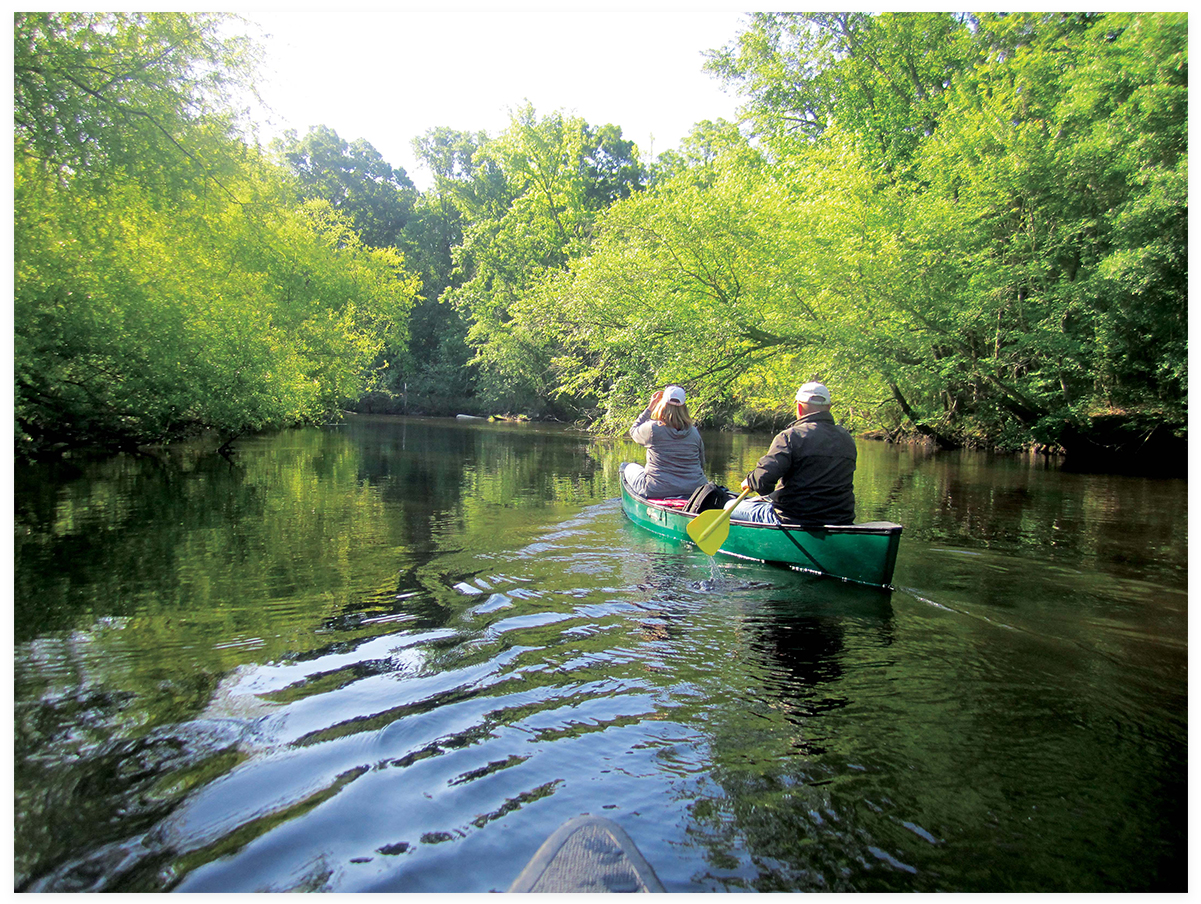
The longest free-flowing blackwater river in North America, the Edisto flows just south of Charleston. Rent a canoe and hitch a ride from Carolina Heritage Outfitters ($40), then set off for a day of quiet contemplation as you paddle your way around each turn of this wild, gorgeous river. When water levels are low, nearly every curve greets you with a wide sandbar, inviting you to spend the afternoon or set up camp for the night. You can also book one of the company’s tree houses for a rustic but charming perch above the river.
Carolina Heritage Outfitters: Hwy. 15, Canadys; canoesc.com
Web Extra: Read our 2016 Summer Guide on the best places to float in the Lowcountry
All mollusks are not created equal. Lowcountry wild oysters grow in thin-shelled clusters that are best served steamed. But clusters are no longer ubiquitous in Charleston. Oyster farmers now raise “singles” in floating farms, growing salty delicacies intended for raw consumption and rivaling purveyors in the Gulf and New England in flavor. Clusters are still the classics in Charleston, and they’re best enjoyed at Bowens Island. First opened in 1946 by May and Jimmy Bowen, this oyster house on Folly Creek is operated by the founders’ grandson, Robert Barber, and his family. Watch the sunset over the marsh, slurping oysters harvested just a few yards away.
Bowens Island Restaurant: 1870 Bowens Island Rd., bowens-islandrestaurant.com
Or, grab a bushel from Crosby’s Seafood (crosbysfishshrimp.com) and invite your neighbors over for a mid-winter backyard roast. If you live in Mount Pleasant, Charleston Oyster Company (localoysters.com) will even deliver them right to your door.
Tips for a Successful Roast:
1. A 55-pound bag of clusters feeds four to six hungry shuckers.
2. Oysters can be cooked on a piece of metal over a fire with a wet burlap sack to produce steam and open the oysters. As soon as they open, they’re ready to eat. Alternatively, steam them in a pot with a basket over a propane burner.
3. To make an oyster table, cut one-foot-wide holes about six inches from both ends of a sheet of 3/4-inch plywood. Place a barrel under each hole to support the board and provide a place to dispose of shells.
4. Save the oyster shells to help build more oyster beds. Find a handy map of drop-off locations at saltwaterfishing.sc.gov/oyster.html.
5. Make your own cocktail sauce for extra points and customized zing.
Cocktail Sauce:
(Makes about 2 cups)
2 cups ketchup
1 Tbs. horseradish (fresh or prepared)
Juice of 1/2 to 3/4 of a fresh lemon
Freshly ground black pepper, to taste
*Note: Let your own taste determine exact measurements in this recipe.
Mix the first three ingredients together. Season with pepper.
Web Extra: Watch our “From Harvest to Table” video at Bowen’s Island
To some, pluff mud is the essence of the Lowcountry. A stinky marsh is a healthy marsh. That whiff of rotten eggs you get when the wind is just right? (We’re not talking about the whiffs of Plum Island from the James Island Connector.) The healthy stench is the spartina grass, fiddler crabs, and everything else out there breaking down into pluff mud. You haven’t lived until you’ve laced up an old pair of tennis shoes and trekked out into it. Watch out for oysters—they’ll cut you up somethin’ ugly—while you paint yourself head to toe in the stinky brown ick. We’re still waiting for somebody to open a pluff mud spa and make a bundle off of this abundant natural resource.
We’ve come a long way since Coast Brewing (1250 N. 2nd St., North Charleston; coastbrewing.com) helped “pop the cap” 20 years ago, changing South Carolina law to allow beers over five percent ABV to be produced. Their leadership opened the door for Holy City Brewing (1021 Aragon Ave., North Charleston, holycitybrewing.com), then Westbrook Brewing (510 Ridge Rd., Mount Pleasant; westbrookbrewing.com), and later dozens of others. Few people know that it was Westbrook’s Gose at Brewvival—a short-lived beer festival hosted by Coast and the future owners of Edmund’s Oast (1081 Morrison Dr. & 1505 King St., edmundsoast.com)—that helped spark a sour beer boom nationwide when the founders of California-based Anderson Valley Brewery sipped it in Charleston. It’s impossible to pick favorites in a town with so much good beer, but we’re partial to a few like the all-organic, waterfront Freehouse Brewery (2895 Pringle St., North Charleston; freehousebeer.com), the rooftop vibes (and tucked-away Folly Beach tasting room) of Revelry Brewing (10 Conroy St. & 13-B Center St., Folly Beach; revelrybrewingco.com), and the funky varieties at the Charles Towne Fermentory (809 Savannah Hwy., chsfermentory.com).
For a creek-to-table experience, use a raw chicken neck to haul in a few hungry crustaceans. Use a simple hand line, or better yet, pick up a hoop net at a tackle shop for as little as $10. Place your bait in the net and lower to the bottom of a creek with a rope (hold on!). Pull it up to check it when you feel movement, or every few minutes. Bring a bucket to put your crabs in, and don’t get pinched! Tip: If you dare pick up a blue crab, hold them at the back end near their swimming legs.
Got a basket full of blue crabs? Check their claws and underbellies to determine the sex. The males (“jimmies”) sport a very distinct Eiffel Tower shape, while the females (“sooks”) have red-tipped claws and a more subdued, rounded-off triangle.
Web Extra: Watch our “Crabbing with Tia” video
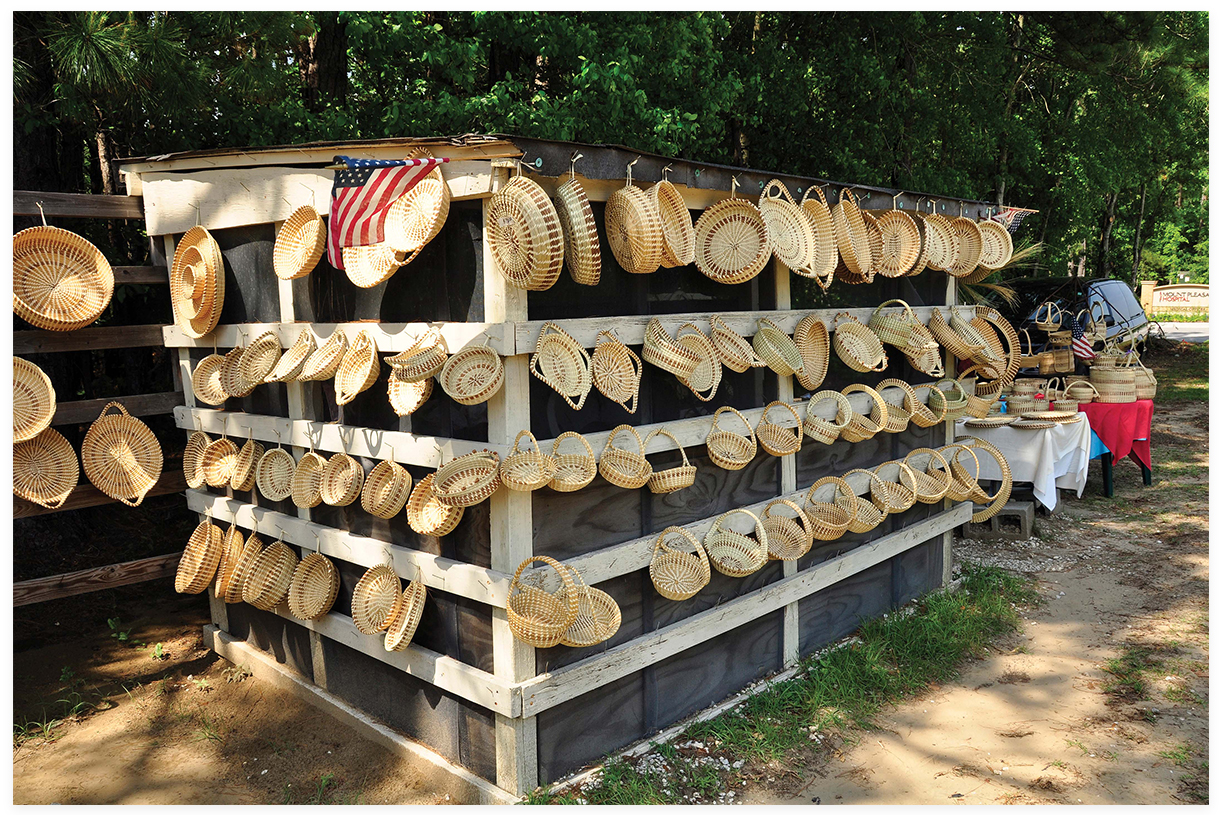
Sweetgrass baskets aren’t cheap, nor should they be. After perfecting the skills handed down from generation to generation—not to mention the fact that a single basket can take weeks to complete—the ladies and gents who weave them on the peninsula and at booths alongside Highway 17 and in the Sweetgrass Pavilion at Memorial Waterfront Park in Mount Pleasant earn every penny. If you purchase a basket, feel free to request a photo; otherwise, it’s an unspoken no-no. It’s okay to strike up a conversation about their skillful craft, even if your pockets are empty.
Learn how to crab with Tia Clark, who hosts a “best-in-the-world” Airbnb Experience; casualcrabbingwithtia.com
Living in the burbs doesn’t offer quite the resonance to Charleston’s illustrious past as downtown’s grand residences. Visiting the Nathaniel Russell (circa 1808), Aiken-Rhett (1820), and Edmondston-Alston (1825) house museums should be on every local’s itinerary. The Nathaniel Russell House nearly went on the market in 2023, making continued public access all the more precious.
For a peek into historic private homes each spring, The Charleston Festival (formerly the Historic Charleston Foundation’s Festival of Houses and Gardens) offers entry into homes dating back to the Colonial period. Come autumn, you can check out even more beautiful digs during the Preservation Society of Charleston’s annual fall tours.
Aiken-Rhett House Museum: Open daily, 10 a.m.-5 p.m (last entry at 4 p.m.) 48 Elizabeth St., historiccharleston.org
Edmondston-Alston House: Open Monday, 1-4 p.m., & Tuesday-Saturday, 10 a.m.-4 p.m. 21 E. Battery, edmonstonalston.org
Heyward-Washington House: Open Monday-Saturday, 10 a.m.-5 p.m., & Sunday, noon-5 p.m. 87 Church St., charlestonmuseum.org
Joseph Manigault House: Open Monday-Saturday, 10 a.m.-5 p.m., & Sunday, noon-5 p.m. 350 Meeting St., charlestonmuseum.org
Nathaniel Russell House Museum: Open daily, 10 a.m.-5 p.m (last entry at 4 p.m.); 51 Meeting St., historiccharleston.org
The Charleston Festival: March 13-April 13, 2025. thecharlestonfestivalsc.com
The Fall Tours: October-November. preservationsociety.org
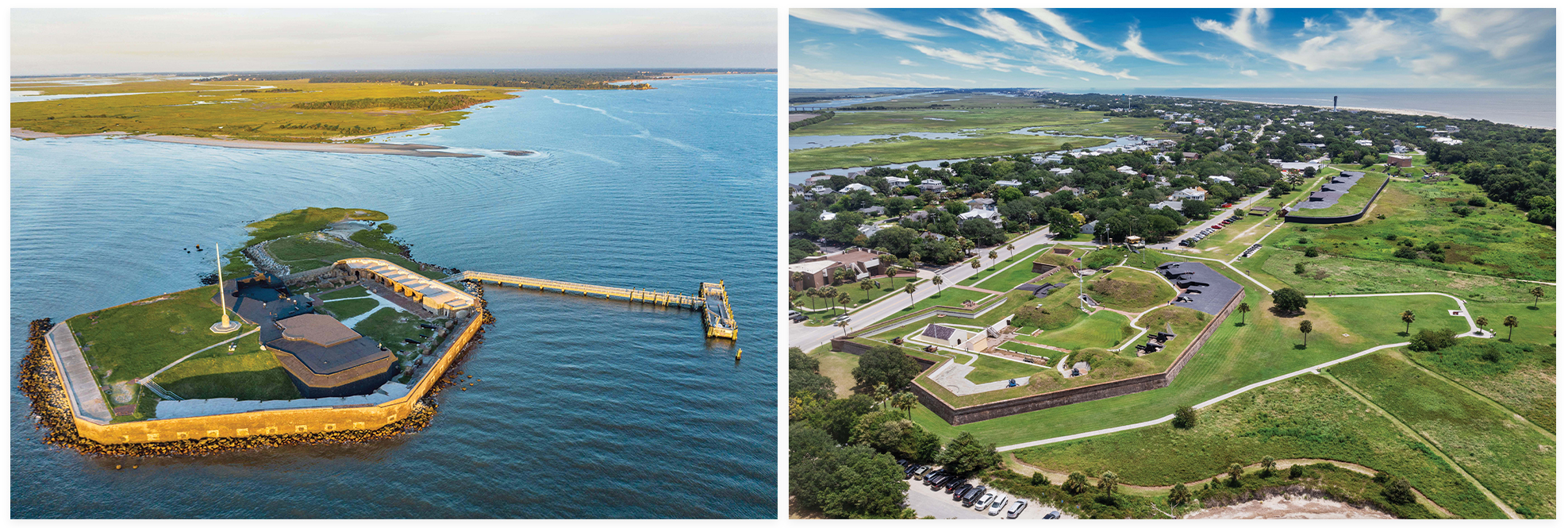
Fort Sumter in Charleston Harbor, (right) Fort Moultrie on Sullivan’s Island.
Charleston Harbor is one of the most consequential bodies of water in the country. During the Revolutionary and Civil wars, whoever controlled access to the harbor held a distinct advantage over supply routes to much of the South. Fort Sumter was the most important fortification, offering 360-degree control at the harbor’s mouth, but Fort Moultrie on Sullivan’s Island and Fort Johnson on James Island (plus Battery Wagner on Morris Island and other smaller fortifications) all played critical roles as shots fired back and forth across the marsh. Fort Sumter is no longer accessible by private boat—you’ll have to take the ferry—but you can drive right up to Fort Moultrie. There’s little left of Fort Johnson but a powder magazine, two oyster tabby cisterns, and earthworks, but it’s an important stop as you imagine the geographical strategizing of the Citadel cadets who fired the first shots of the Civil War from here in 1861.
Fort Sumter: Tour boats depart from Liberty Square downtown and Patriot’s Point in Mount Pleasant. fortsumtertours.com
Fort Moultrie: 1214 Middle St., Sullivan’s Island; nps.gov
Fort Johnson: Fort Johnson Rd., James Island; dnr.sc.gov
The Holy City may have more hotels than churches these days, but one positive about the boutique lodging boom is the proliferation of rooftop bars open to locals. The Rooftop at the Vendue and the Pavilion Bar at the Market Pavilion Hotel are the worthy classics, now joined by the snazzy modern art at Élevé atop the Grand Bohemian and panoramic views at the Dewberry’s Citrus Club. Along the King Street corridor, there’s The Watch at the Restoration Hotel, Fiat Lux at Hotel Bennett, and Pour Taproom at the Hyatt House, which nabs the award for highest bar in town. Book a stay at The Loutrel to access their tranquil terrace, perhaps our favorite rooftop for a low-key sunset, or brave the crowd at Little Palm at the Ryder Hotel, known for its creative cocktails and buzzy pool scene just above Meeting Street. Finally, if you want to appreciate an old-school view of the city, head across the Ashley River to the Harborview Lounge on the top floor of the iconic round Holiday Inn.
In a city as old as Charleston, creating a new must-see destination seems impossible, but the IAAM should be at the top of every visitor’s list—and every local’s, if you haven’t already been. The museum’s location at Gadsden’s Wharf, where enslaved people were shackled as they first set foot in the New World, adds to the poignancy of an experience that expertly balances stories of suffering and the ongoing struggle for Black empowerment with celebrations of the cultural, musical, and culinary contributions of African American communities and individuals to our nation’s fabric. Rotating exhibits from visiting artists and historical collections encourage repeat visits, and the gardens and grounds (always open, always free) offer a place to sit and reflect. 14 Wharfside St., Tuesday-Sunday, 10 a.m.-5 p.m., iaamuseum.org
Foggy nights can be tough to find in the Lowcountry, but if you get just the right clash of air and water temperatures to leave a haze floating in the air, head downtown for a haunting experience. Although ghost tours are typically the realm of gullible tourists, the stories all have real historical roots. Join in and assuredly play the well-informed local, verifying the most chilling details of your guide’s stories to frightened visitors.
Bulldog Tours: bulldogtours.com
Ghosts of the South: scarycharleston.com
Ghost Walk: ghostwalk.net
The Ghosts of Charleston Tour: buxtonbooks.com
Formed in 1930 after the president of the Garden Club of Charleston found herself inspired in Paris, downtown’s Gateway Walk meanders through the peaceful gardens and cemeteries of multiple churches—St. John’s Lutheran, Unitarian, Circular, and St. Philip’s—as well as the Library Society and the Gibbes Museum of Art. It’s a bit hard to find and follow, but experiencing the quiet natural respites amid the bustle of the city is well worth it. thegardenclubofcharleston.org
Trying to give directions downtown can stump just about anybody when it comes to pronouncing odd street names like Beaufain (Bu-fane), Legare (La-gree), Huger (Hew-gee), Hasell (Hazel), Barre (Barry), and Vanderhorst (Van-dross). Say them right and earn some local street cred.
In 1909, Mayor Goodwyn Rhett’s cook, William Deas, stirred up the now legendary bisque topped with decadent roe for a dinner for President William Taft. That recipe later made Everett’s Restaurant on Cannon Street famous in the ’50s, ’60s, and ’70s. Today, “she-crab” soup might draw from any local crab meat, but it’s still silky and rich when done right.
Web Extra: Get Mr. Deas’s recipe at charlestonmag.com/recipes/the_original_she_crab_soup.
To an outsider, a rice spoon may appear to be little more than a shiny utensil fit for a very hungry giant, but this elegantly simple serving piece is a must in any Charleston dining room. During the Colonial period, the Lowcountry was America’s largest producer and exporter of rice, made possible by the work of enslaved people. During the early 20th century, a long-handled spoon was used to serve rice for dinner (typically at 2 p.m.). Today, you can pick up a quality rice spoon for $25 from Carolina Gold rice grower Carolina Plantation Rice, or splurge at Croghan’s Jewel Box for an engraved Reed & Barton model ($50). Got a host of Charleston weddings to attend this spring? Stock up on rice spoons.
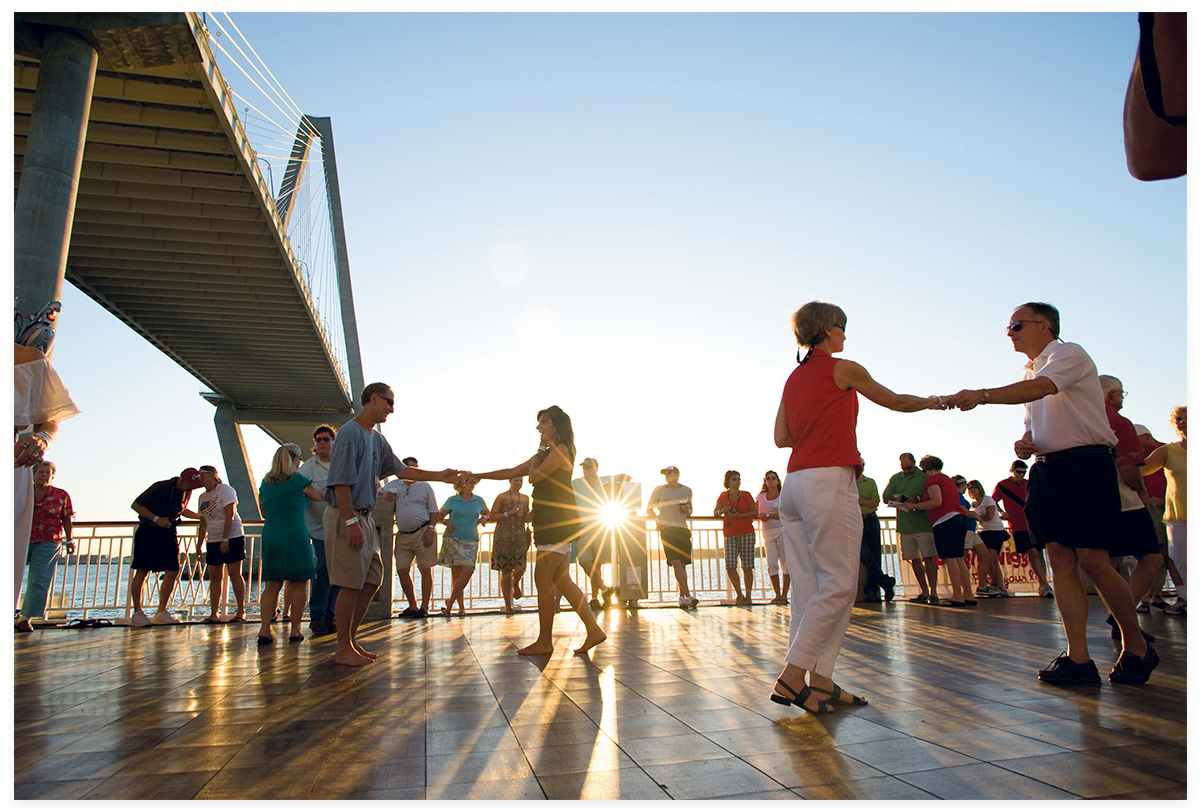
Although born on Broadway in the 1920s, the Charleston’s kick-and-step routine is said to have been inspired by the Holy City’s own Jenkins Orphanage Band while on tour in New York City. Regardless, the popular dance sent a reminder about our port city around the world, with the Charleston making its way to European stages within a few years. Perfect your moves at home and you’ll be the star of every dance floor you encounter.
Show off your new steps or stick to the classic Carolina shag (a dance that keeps one hand free for your beverage of choice) at Charleston County Parks’ summertime Moonlight Mixers on the Folly Beach Pier and Dancing on the Cooper events at the Mount Pleasant Pier. (ccprc.com)
Along the upper reaches of the Ashley River in Summerville, the Colonial Dorchester State Historic Site is off the radar of most visitors and even many locals, but it’s a stunning locale that includes both the haunting bell tower of St. George’s Anglican Church (left standing after the building burned during the Revolutionary War) and the walls of a fort built with oyster tabby. The “concrete” of the Lowcountry’s colonial days was created by mixing oysters shells roasted down to a lime paste with broken shell pieces and sand. After you admire the thick oyster shell walls, take a walk around the trails and woods of the 325-acre site. 300 State Park Rd., Summerville; southcarolinaparks.com/colonial-dorchester
Even come’yahs (newcomers) speak a bit of Gullah—the folk song “Kumbayah” translates to “come by here”—but they’ll still be hard-pressed to understand the Sea Island Creole dialect of African American bin’yah (“been here”) communities.
For a real taste of Gullah culture, take a drive with Gullah Tours’ Alphonso Brown. His website (gullahtours.com) offers a handy glossary (including some audio) to help you learn key phrases before your tour.
Boddun: bothered, worries
'Cajun: occasion
Cawnfiel’: corn field(s)
Crackuhday: crack or break of day
Leggo: let go, let’s go, letting go
Lem’Lone: let him/her/them alone
Osiituh: oyster(s)
Pooty: pretty
T’reetime: three times
W’Ymesko: what makes it so, why
Web Extra: Listen to Gullah - Hear the Lord’s Prayer and the 23rd Psalm as translated by Gullah Tours guide Alphonso Brown.
For Citadel cadets, nothing kicks off the weekend like dressing up in wool and marching in straight lines and hard right angles. At 3:45 each Friday afternoon during the school year, more than 2,500 of them grab their swords, rifles, or instruments (the regimental band may be the parade’s highlight) and strut their stuff around Summerall Field. The Citadel, 171 Moultrie St., Summerall Field, citadel.edu/visit-the-citadel/parade-schedule/
Since it washed up during Hurricane Hugo, the Folly boat has seen thousands of well-wishes and announcements painted in deep layers across its port side. In 2017, Tropical Storm Irma refloated the boat to the marsh along Sol Legare Road. A Folly Road business owner paid to move it back to its current location just past Battery Island Drive. The first-come, first-serve canvas often gets a new coat several times a day. Whether you’ve got an engagement, an event, or just a strong sentiment to announce, it’s yours to decorate. Just remember to park well off of Folly Road and take your paint cans with you when you leave.
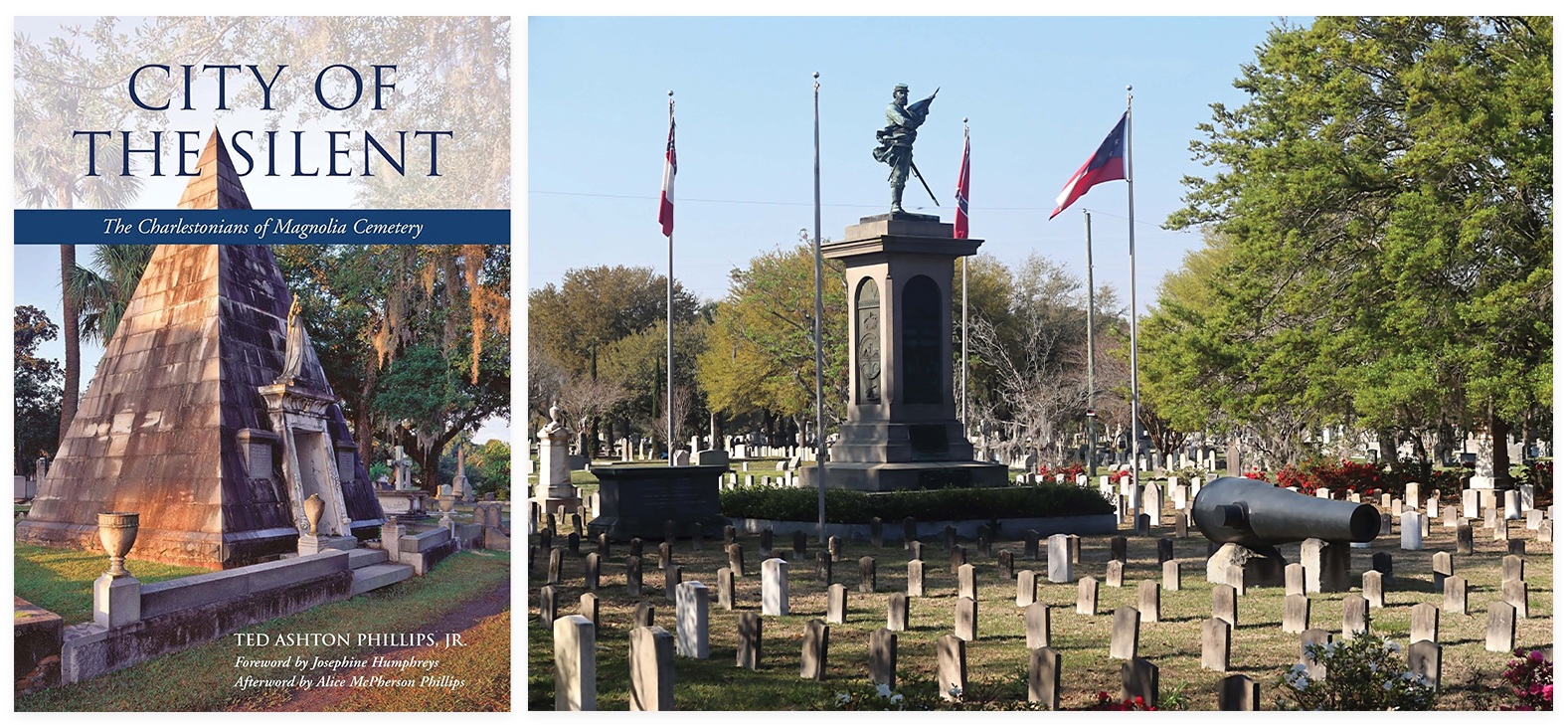
Magnolia Cemetery.
Magnolia Cemetery provides an eternal resting place for many of Charleston’s most influential citizens since the Civil War. The crew members of the CSS H.L. Hunley are buried here, along with 35,000 other Charlestonians. Late attorney and historian Ted Phillips, Jr. captured the lives of these politicians, bootleggers, farmers, and generals in his book, City of the Silent (USC Press, 2010). Sit in the tranquil grounds and read their stories.
Each year as spring gives way to summer, Spoleto Festival USA (May 23-June 8, spoletousa.org) and its local sibling, Piccolo Spoleto (piccolospoleto.com), fill downtown with Grammy-caliber live music, debuts of international operas, acrobatic circus acts, and elaborate dance and theatrical productions. Concerts in the College of Charleston’s Cistern Yard are a highlight. Situated in the heart of the city but draped in natural splendor, it’s a venue like no other and has inspired artists like Jon Batiste, Chris Thile, and Madeleine Peyroux to perform with unbridled joy.
As the season changes again in late September, MOJA Arts Festival (mojafestival.com) celebrates African American and Caribbean dance, writing, visual arts, and music. Curated by trumpeter and artistic director Charlton Singleton, MOJA brings stars of reggae, gospel, jazz, and comedy to town for 11 days of performances. Concerts at Hampton Park, including the finale, are perfect for an outdoor afternoon in a lawn chair or on a picnic blanket.
Whatever your sport of choice, there’s likely a team for you in the Holy City. In two seasons at the helm of the Charleston Battery (charlestonbattery.com), coach Ben Pirmann has brought Lowcountry soccer back to regional dominance. The oldest continuously operating professional soccer team in the nation has reached its conference championship two years in a row. The most celebrated local team may be the RiverDogs (milb.com/charleston), who won the city’s first minor league baseball title in nearly a century in 2021, repeating the feat in 2022 and 2023. The College of Charleston baseball players are also regular contenders, but it’s Cougar basketball (cofcsports.com) that sells out its season tickets after league titles and trips to the NCAA Tournament in 2023 and 2024. The peninsula even offers all the pomp and circumstance of Division I college football at Citadel games (citadelsports.com) each fall. And when the gridiron shuts down, the South Carolina Stingrays pro ice hockey team (stingrayshockey.com) keeps skating through the winter.
If you take your Yankee friends out to dinner at The Wreck on Shem Creek, they might look apprehensively at the bowl of soggy legumes the server sets on the table. Don’t fret—that just means more for you. But as Charleston’s roadside stands disappear, leaving the canned variety at gas stations as the primary option, it’s better just to make your own. Boil up a big pot of water, add some salt, and toss in a few pounds of “green” peanuts (in season from July through September). Once the water boils, turn the temperature to low and let the peanuts simmer. Spice them up to your liking. Depending on how soft you like them, they’re done when you say they are—although it should take at least a couple of hours to boil them proper. The longer they sit in the water, the saltier they’ll be. Bring ’em to the beach, on the water, or just to a friend’s house, and you’re guaranteed to be invited back again and again.
Web Extra: Watch Matt Lee of the Lee Brothers make boiled peanuts
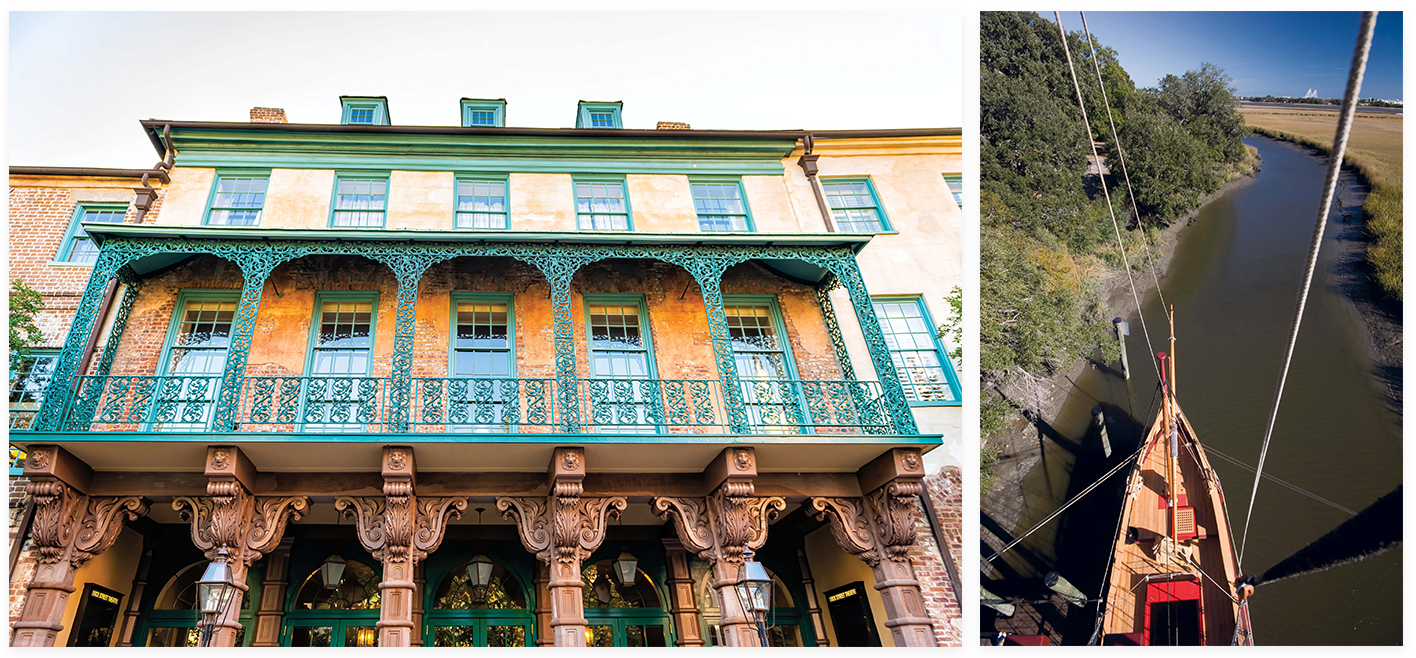
(Left) Dock Street Theatre; (Right) The Adventure replica at Charles Towne Landing.
Built in 1736, the Dock Street Theatre is the first building in the country designed specifically for theatrical performances. Although it burned four years later, its legacy remained strong until 1937, when a new version of the theater hosted its second grand opening, almost precisely two centuries later. Today, the Dock Street is home to Charleston Stage, which produces more than 100 theatrical performances each year. 135 Church St., charlestonstage.com
A quiet gem among our local attractions, Charles Towne Landing features an impressive 660-acre preserve just minutes from downtown. The first settlers’ original landing point includes The Adventure (a seaworthy replica of a 17th-century cargo vessel), a small fort, a museum, and a zoo called the Animal Forest. Yes, there are bears, pumas, and bison in this natural habitat for native species, and you can see them all for just $12.
Charles Towne Landing: 1500 Old Towne Rd., southcarolinaparks.com/charles-towne-landing
This February, the Charleston Symphony Orchestra travels to New York City for its Carnegie Hall debut with a performance that includes composer Edward Hart’s “A Charleston Concerto.” But locals can experience their 88-year-old symphony with a quick trip to the Gaillard Center, where the 1,800-seat performance hall was designed and refurbished to facilitate optimal sound for a symphony. charlestonsymphony.org
For more than 15 years, the good folks at Awendaw Green have hosted weekly Wednesday-night Barn Jams (6-10 p.m., $10 donation, awendawgreen.com) in a shed on the grounds of the Sewee Outpost store on Highway 17. For the full experience, arrive with enough daylight to play a round of Frisbee golf at the on-site 18-hole course. Fill your cooler at the Outpost and grab a front-row bench for an eclectic lineup of musicians.
Since the first Barn Jam, Charleston has seen an incredible array of new outdoor music options open, taking advantage of our year-round good weather. On the Neck, the Refinery (therefinerychs.com) hosts a full slate of local and touring acts, and the deck outside the Charleston Pour House (charlestonpourhouse.com) on James Island doubles the venue’s bookings, with outdoor shows almost every evening. Big-name acts now make regular stops at Firefly Distillery (fireflydistillery.com), while Credit One Stadium (creditonestadium.com) brings stars like Elton John and Stevie Nicks to the Lowcountry.
Charleston’s shrimping fleet has dwindled dramatically due to competition from Asia and high dock rents, so the hard-working folks still plying the waters need all the help they can get. When shrimping season kicks off each spring, the public gathers in Mount Pleasant for the Blessing of the Fleet. In addition to music, food, and shag dancing, attendees can watch clergy bless each boat and its crew for a prosperous, safe catch.
The Blessing of the Fleet: April 27, 2025. Memorial Waterfront Park & Pier, Harry M. Hallman, Jr. Blvd., Mount Pleasant. Free. experiencemountpleasant.com/event/blessing-of-the-fleet-seafood-festival
Legend has it that the nation’s first joggling board was built on Acton Plantation in Sumter County to help alleviate the rheumatism of Mrs. Benjamin Kinlock Huger with gentle exercise. We’ve also heard that those funny rocking benches ubiquitous on Lowcountry porches are a Victorian courting device, designed to bounce a couple from the ends to the middle, where they will accidentally touch. Of course, we prefer the latter.
Give it a try at Magnolia Plantation or Middleton Place, each of which sports joggling boards in scenic locales, or get your own from the Old Charleston Joggling Board Company (oldcharlestonjogglingboard.com)

Local dolphins hit the shoreline for a meal.
Just like our people, the Lowcountry’s dolphins are extra special. Strand feeding, a phenomenon during which Atlantic bottlenose dolphins team up to force a school of fish (typically mullet) on shore, where they can be easily caught and eaten, occurs along the South Carolina and Georgia coasts. Most local sightings are reported along the Kiawah River and Bohicket Creek. Catching them in action requires luck, but September and October are prime months, when mullet are bountiful. Follow pelicans to a school of fish or look out for dolphins raising their eyes above the surface to scout out a mud bank at mid-to-low tide.
Web Extra: Watch this intriguing dolphin feeding behavior
Share photos of your Charleston Bucket List adventures and tag us for a chance to be featured in a future issue! #charlestonMagBucketList2025
Photographs by DENCG/Shutterstock; (steeples & skyline) Media Group/Shutterstock & (church interior) Melinda Smith Monk; photographs by (Full Moon) Justin Morris, (Angel Oak) Taylor Horton, & (Hoppin’ John) Brent Hofacker/Shutterstock & Courtesy of (Map) HISTORIC CHARLESTON FOUNDATION; images by (Glass) Bildagentur Zoonar/Shutterstock, (Surfer) Justin Morris, (Drawing) Morphart Creation/Shutterstock, & (Tea setup) beto_chagas/AdobeStock & Courtesy of (Madeira bottle) Rare Wine Co.; photograph by makasana photo/ Shutterstock; photograph courtesy of Charleston Charter Fishing; photograph by Brent Hofacker/Shutterstock; photographS by (SHARK TEETH) I. Pilon/shutterstock & (CANOE) Alice Tubley; photographs by (Cabins) meunierd/shutterstock & (Oysters) Rebekah Arnson; photographs by (basket stand) Charles F. Gibson/Shutterstock & (Tia Clark) Lizzy Ervin; photographs by (Fort Sumter) George A. Kenna/Shutterstock; (Fort Moultrie) tokar/shutterstock; & (Martini) Palmer Kane/Shutterstock & Courtesy of (Bar) Pavilion Bar; photographs by (Soup) Sara Tiberio & (spoon) Taylor Horton; photographs by (Cemetery) Al Munroe/shutterstock & courtesy of (SHAGGING) TOWN OF MOUNT PLEASANT PARKS & RECREATION; photographs by (Matt Lee) Nate Leach, (Peanuts) JIANG; HONGYAN/Shutterstock, & (Theater) Andriy Blokhin/Adobe Stock; photographs by (CHARLES TOWNE LANDING) PERRY BAKER & (Baseball) Elias McCall; photographs by (DOLPHINS) PATRICIA SCHAEFER & (awendaw green) Stephanie Smith